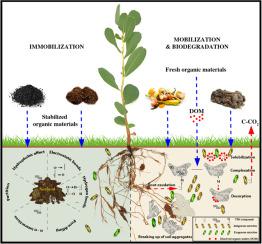Journal of Hazardous Materials ( IF 12.2 ) Pub Date : 2021-03-22 , DOI: 10.1016/j.jhazmat.2021.125702 Son A Hoang 1 , Binoy Sarkar 2 , Balaji Seshadri 3 , Dane Lamb 4 , Hasintha Wijesekara 5 , Meththika Vithanage 6 , Chathuri Liyanage 6 , Pabasari A Kolivabandara 6 , Jörg Rinklebe 7 , Su Shiung Lam 8 , Ajayan Vinu 4 , Hailong Wang 9 , M B Kirkham 10 , Nanthi S Bolan 3

|
The term “Total petroleum hydrocarbons” (TPH) is used to describe a complex mixture of petroleum-based hydrocarbons primarily derived from crude oil. Those compounds are considered as persistent organic pollutants in the terrestrial environment. A wide array of organic amendments is increasingly used for the remediation of TPH-contaminated soils. Organic amendments not only supply a source of carbon and nutrients but also add exogenous beneficial microorganisms to enhance the TPH degradation rate, thereby improving the soil health. Two fundamental approaches can be contemplated within the context of remediation of TPH-contaminated soils using organic amendments: (i) enhanced TPH sorption to the exogenous organic matter (immobilization) as it reduces the bioavailability of the contaminants, and (ii) increasing the solubility of the contaminants by supplying desorbing agents (mobilization) for enhancing the subsequent biodegradation. Net immobilization and mobilization of TPH have both been observed following the application of organic amendments to contaminated soils. This review examines the mechanisms for the enhanced remediation of TPH-contaminated soils by organic amendments and discusses the influencing factors in relation to sequestration, bioavailability, and subsequent biodegradation of TPH in soils. The uncertainty of mechanisms for various organic amendments in TPH remediation processes remains a critical area of future research.
中文翻译:

使用有机改良剂减轻石油-碳氢化合物污染的危险土壤的研究进展
术语“石油烃总量”(TPH)用于描述主要衍生自原油的石油基烃的复杂混合物。这些化合物被认为是陆地环境中的持久性有机污染物。越来越多的有机改性剂被用于修复被TPH污染的土壤。有机改良剂不仅提供了碳和养分的来源,而且还添加了外源有益的微生物来提高TPH的降解率,从而改善了土壤的健康状况。在使用有机改良剂修复被TPH污染的土壤的情况下,可以考虑以下两种基本方法:(i)增强TPH对外源有机物质的吸附(固定化),因为它降低了污染物的生物利用度,(ii)通过提供解吸剂(移动化)以提高随后的生物降解来增加污染物的溶解度。在将有机改良剂应用于受污染的土壤后,均已观察到TPH的净固定化和动员。这篇综述探讨了通过有机改良剂增强TPH污染土壤修复的机制,并讨论了与TPH的螯合,生物利用度和随后的生物降解有关的影响因素。TPH修复过程中各种有机修饰的机制的不确定性仍然是未来研究的关键领域。在将有机改良剂应用于受污染的土壤后,均已观察到TPH的净固定化和动员。这篇综述探讨了通过有机改良剂增强TPH污染土壤修复的机制,并讨论了与TPH的螯合,生物利用度和随后的生物降解有关的影响因素。TPH修复过程中各种有机修饰的机制的不确定性仍然是未来研究的关键领域。在将有机改良剂应用于受污染的土壤后,均已观察到TPH的净固定化和动员。这篇综述探讨了通过有机改良剂增强TPH污染土壤修复的机制,并讨论了与TPH的螯合,生物利用度和随后的生物降解有关的影响因素。TPH修复过程中各种有机修饰的机制的不确定性仍然是未来研究的关键领域。














































 京公网安备 11010802027423号
京公网安备 11010802027423号